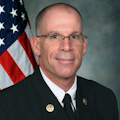A few weeks ago, I had the honor of presenting a program at the second annual Crew Resource Management Symposium in Pflugerville, TX. Despite my enthusiasm for the topic, in the weeks leading up to my presentation, I admittedly struggled to come up with a message that I felt would resonate with the audience, representing firefighters and fire officers from across the country. After all, crew resource management (CRM) had been a topic of discussion for many years, and its acceptance nationally within the fire service, I felt, was lackluster at best.
The week prior to the symposium, I traveled to Coronado, CA—the home of the elite Navy SEALs—to compete in the SuperSEAL triathlon. Oddly enough, it was during the “quiet time” of my swim, bike and run that it hit me—the Navy SEALs represent CRM at its best.
When CRM was first introduced to the fire service, many—myself included—used the aviation industry as an example of how CRM could improve crew performance and, ultimately, fireground safety and operational effectiveness. While the track record of the aviation industry post-CRM is admirable, for the fire service, it lacked the swagger and self-worth that comes with a comparison equal to that of the elite Navy SEALs.
The Navy SEALs represent the best of the best. Their track record of success and operational effectiveness is not based on the physical or mental abilities of an individual, but rather the collective capabilities of the team. This team cohesiveness is not by happenstance; it's the product of rigorous mental and physical training, the development of individual trust, and an exhaustive focus on team-based performance.
After sharing my presentation with the attendees, two chief officers from two separate departments approached me and asked if I had read ret. Army General Stanley McChrystal’s book Team of Teams. I had to admit that hadn’t read it, but based on their recommendation, I would certainly do so.
The next day, while sitting in the morning session, one of the chiefs presented me with a copy of McChrystal’s book and again insisted that I take the time to read it. On my return flight home, I began reading Team of Teams, anxious to understand why these two chiefs were so insistent that I read this book. As I began reading, it didn’t take long for me to understand the reasoning behind their recommendation. Charged with transforming the way the special operations community operated and changing the way the Army wages the War on Terror, General McChrystal had suggested that innovation and problem-solving become the products of teamwork, not the work of a ranking individual. He referenced the aviation industry’s use of CRM and the operational effectiveness of the Navy SEALs as a model for modern warfare.
Traditionally, the fire service, like the military, has been very linear in our approach to fireground operations and problem-solving. We promote individuals to various ranks within the organization and hold them accountable for the actions and performance of the men and women assigned to them. Directives are given from ranking individuals, and subordinates are expected to take action accordingly. This approach, while proven successful at times, has also proven to be less than effective in times of high-stress and fast-paced operations commonly seen on the battlefield and the modern fireground.
In stark contrast, by practicing the principles of CRM, the Navy SEALs demand and employ the qualities of physical courage, moral courage, creativity, team ability and humility, all of which enable them to achieve unequaled success.
Physical courage represents an individual’s willful desire and dedication to develop and maintain a level of physical fitness and mental readiness to achieve the mission at all times. Moral courage is about developing the trust and respect of your crew and those you serve. Creativity is one’s ability to solve problems as a team and to overcome the unknown. Team ability represents the responsibility of each individual to lead and/or follow, regardless of their respective rank. Humility represents an openness to learn and to never allow ones status or accomplishments to interfere with or impede the opportunity to improve.
In its infancy, CRM was labeled as the “Charm School” for pilots, a punishment imposed upon the pilots by the ranking authorities. Today, CRM is a model of proven success, a model that creates an immeasurable level of safety and operational effectiveness in the skies overhead and the battlegrounds of our modern day warriors. Maybe it’s time WE (the American fire service) revisit the concept of “Charm School.”
About the Author

Timothy E. Sendelbach
Editor-in-Chief
Timothy E. Sendelbach is a 30-year student and educator of the fire and emergency services, and former editor-in-chief for Firehouse. He has served as an assistant fire chief with the North Las Vegas, NV, Fire Department, as the chief of training for Savannah (GA) Fire & Emergency Services and as assistant fire chief for Missouri City, TX, Fire & Rescue Services. He is a credentialed Chief Fire Officer and Chief Training Officer and has earned a master’s degree in leadership from Bellevue University, bachelor’s degrees in fire administration and arson and an associate’s degree in emergency medical care from Eastern Kentucky University.
